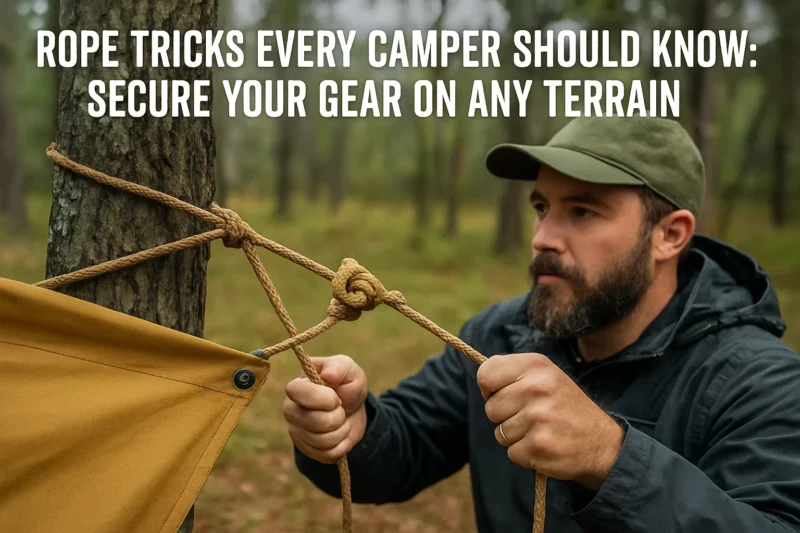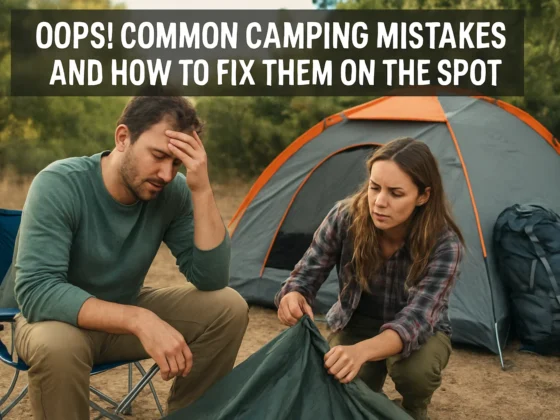Introduction: The Camper’s Silent Skill
When people think of camping skills, they often imagine pitching tents, cooking outdoors, or starting a fire. But there’s a less glamorous skill that quietly makes everything run smoother: rope work.
Knowing how to tie the right knot, set up a line, or tension a tarp can mean the difference between a comfortable, weatherproof camp and a long, frustrating night. It’s one of those skills you don’t realize you need—until you do.
Whether you’re securing a camping tarp, hoisting food away from animals, or repairing gear on the trail, rope tricks are a lightweight, versatile, and invaluable addition to your outdoor toolkit.
Why Rope Skills Matter for Campers
Rope work isn’t just about survival—it’s about efficiency, comfort, and safety.
-
Adaptability: One length of cord can serve countless purposes, from gear repair to shelter building.
-
Space & Weight Efficiency: Rope is light to carry but has endless applications.
-
Safety: Proper knots prevent accidents, whether that’s gear falling on someone or a shelter collapsing in strong wind.
And unlike high-tech gear, rope doesn’t need batteries or a signal—it just needs your know-how.
Essential Gear for Rope Work
Before we talk knots and tricks, let’s go over the basic tools:
-
Paracord: Lightweight, strong, and versatile. Ideal for most camping needs.
-
Climbing Rope: For load-bearing tasks or rescue situations.
-
Guy Lines: Pre-cut ropes with tensioners, great for shelters.
-
Carabiners: Quick connection points for ropes and gear.
-
Tent Stakes or Anchors: Secure lines to the ground.
-
Camping Tarp: A durable tarp is the perfect partner for rope work, giving you shelter from sun, wind, and rain.
A high-quality camping tarp—like the Uniflame Revo Square Tarp—paired with the right rope tricks can create instant shade, windbreaks, or rain protection.
Must-Know Knots for Campers
There are hundreds of knots out there, but these core knots cover almost every camping situation:
1. Bowline Knot – The “Rescue” Loop
-
Creates a fixed loop that won’t slip under load.
-
Perfect for securing a rope around a tree or post without tightening too much.
-
Great for setting up hammocks or creating anchor points.
How to tie: Make a loop, pass the end up through it, around the standing rope, and back down through the loop.
2. Taut-Line Hitch – Adjustable Tension
-
Creates a sliding knot that can be tightened or loosened without untying.
-
Ideal for adjusting tent guy lines or tarp tension.
How to tie: Wrap the rope twice inside the loop near the anchor, then once outside before tightening.
3. Clove Hitch – Quick Temporary Hold
-
Fast and easy for securing rope to a pole or stake.
-
Best for temporary lashings or where you might need to adjust frequently.
How to tie: Wrap the rope around the post twice, crossing over, then tuck under the last wrap.
4. Trucker’s Hitch – Maximum Tension
-
Acts like a pulley for super-tight lines.
-
Great for keeping tarps taut during heavy wind.
How to tie: Create a loop mid-line, thread the free end through your anchor, and pull tight before securing with half hitches.
5. Figure Eight Knot – Prevents Slipping
-
Stops rope from fraying or pulling through holes.
-
Simple stopper knot for the end of any line.
Practical Rope Tricks for the Campsite
1. Securing a Camping Tarp Shelter
String a ridgeline between two trees, drape your camping tarp over it, and secure the corners with taut-line hitches to stakes. This setup works for shade, wind protection, or rain cover.
2. Hanging Food to Keep It Safe from Wildlife
Tie a rope to a bag of food and hoist it over a tree branch at least 10 feet high and 4 feet from the trunk. Use a clove hitch to secure it once lifted.
3. Creating a Clothesline
Stretch a length of paracord between two points using taut-line hitches for easy tightening. Keeps clothes and towels off the ground to dry faster.
4. Emergency Gear Repair
A snapped backpack strap, broken tent pole, or ripped sleeping bag can all be temporarily fixed with rope lashings. Paracord is especially good for reinforcing weak points.
5. Improvised Stretcher or Carry Sling
By weaving rope between two sturdy poles, you can create a makeshift stretcher for transporting an injured camper short distances.
Rope Safety Tips
-
Always check your rope for frays or damage before use.
-
Avoid sharp bends under heavy load, as they weaken the rope.
-
Never use thin paracord for load-bearing situations like climbing.
-
Practice knots at home before relying on them in the wild.
Advanced Rope Techniques for Enthusiasts
If you want to take your rope skills further, consider learning:
-
Shear Lashing: To bind poles together for tripods or frameworks.
-
Prusik Knot: A friction hitch that grips the main rope, useful for climbing or rescue.
-
Square Lashing: For building stable camp furniture or structures.
These skills open up possibilities for more ambitious setups, from suspended tarps to multi-point shelters.
Real-World Scenarios
Scenario 1: Sudden Rainstorm
You’re on a beach camp when clouds roll in fast. With your pre-knotted guy lines, you throw up a tarp shelter in minutes using trucker’s hitches for maximum tension. Everything stays dry until the rain passes.
Scenario 2: Strong Winds Overnight
While camping in Tanay, you hear the wind pick up. You get out, adjust the taut-line hitches on your guy lines, and your tarp holds steady instead of collapsing.
Scenario 3: Broken Tent Zipper
At a remote site, your tent zipper fails. You lash the opening closed with paracord in a zigzag pattern. It’s not perfect, but it keeps the bugs out until you get home.
Building a Rope Kit for Camping
A good rope kit is small, lightweight, and always accessible:
-
50 ft of paracord
-
20 ft of heavier-duty rope
-
6–8 aluminum tent stakes
-
4 lightweight carabiners
-
1 high-quality camping tarp
-
Small mesh bag to store it all
Final Thoughts: Rope Skills Are an Investment
Learning rope tricks is like learning a language—the more you know, the more you can “say” with your gear. A simple length of cord, paired with a reliable camping tarp, can give you shelter, security, and solutions to problems you didn’t know you could solve.
The best part? Rope skills don’t wear out or run out of battery. Once you learn them, they’ll serve you on every trip, from the nearest camp sites near Manila to the most remote wilderness you can reach.


